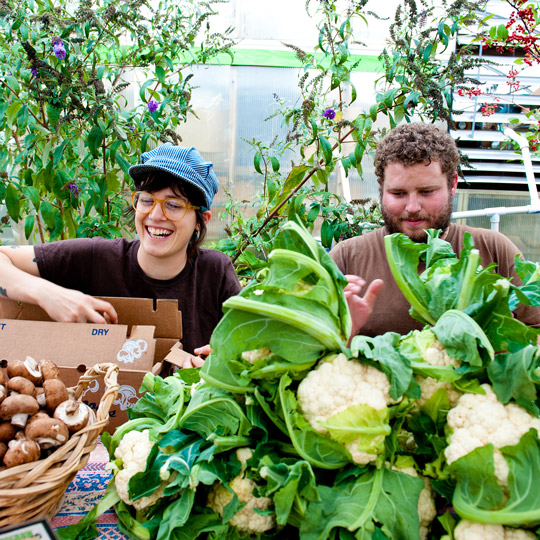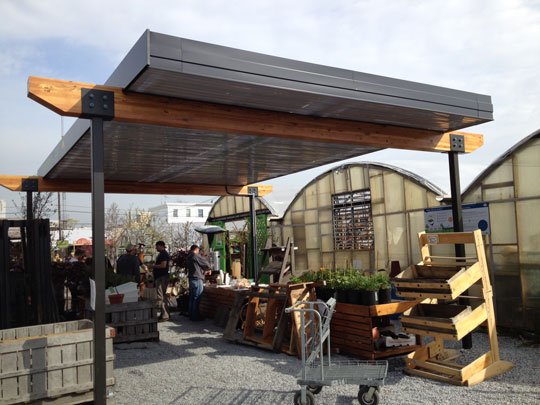 Green Mountain Energy’s Sun Club “flipped the switch” on its largest solar installation in Philadelphia at Greensgrow Farms on Earth Day. | Photos courtesy of newsworksGreen Mountain Energy donates solar panels
Green Mountain Energy’s Sun Club “flipped the switch” on its largest solar installation in Philadelphia at Greensgrow Farms on Earth Day. | Photos courtesy of newsworksGreen Mountain Energy donates solar panels
to community organizations
The large wooden stand high above the heads of customers picking through vegetables at Greensgrow Farms in North Philadelphia does more than just shield the sun while they shop—it’s pulling solar power, too. Equipped with 16 solar panels, the array provides the urban farm with clean, renewable energy. All told, the 5,000 kilowatt hours of power the solar array is expected to produce every year could save the organization about $1,000.
But Greensgrow Farms could not have done it alone. The nonprofit recently received a $20,000 grant from Sun Club, Green Mountain Energy’s program that provides solar panels and power systems for local organizations looking to better their communities. While the Texas-based company has been selling renewable energy since 1997, it expanded its operations to the Philadelphia area in 2012 and began looking for community organizations to offer funding for solar projects. The company now serves customers in Texas, Illinois, Maryland, New York, New Jersey and Pennsylvania in markets where customers have the power to choose their electricity provider.
Rebecca Frimmer, the then-manager of Greensgrow, says solar power fits in perfectly with the farm’s mission. “We always talk about ways to make Greensgrow and Philly more sustainable,” Frimmer says. “It really did seem like a natural fit for us on the farm to have that clean energy.”
She said the building and installation of the solar farm stand only deepened the relationship with the Sun Club and Green Mountain Energy, adding that when Greensgrow needs help with a new planting project—or educating the community on healthy foods or urban farming—more than 15 Sun Club employees will volunteer to help. And Tony Napolillo, the Sun Club manager at Green Mountain Energy, hopes the company can continue to participate in future events at Greensgrow Farms and at the other groups the Sun Club is helping through its grant program.
“We are not just a company that buys renewable energy and acts like everybody else,” Napolillo says. “We all have this passion to make this a better world, and renewable energy can help with that.”
 Equipped with 16 solar panels, the array provides Greensgrow with clean, renewable energy and could save the organization about $1,000 in energy costs every year.In addition to Greensgrow, the Sun Club is helping three other groups purchase and install their own solar arrays: Spring Mill Fire Company in Conshohocken, Pa.; the Pennsylvania Horticultural Society’s Meadowbrook Farm in Abington Township; and Green Woods Charter School in Northwest Philadelphia.
Equipped with 16 solar panels, the array provides Greensgrow with clean, renewable energy and could save the organization about $1,000 in energy costs every year.In addition to Greensgrow, the Sun Club is helping three other groups purchase and install their own solar arrays: Spring Mill Fire Company in Conshohocken, Pa.; the Pennsylvania Horticultural Society’s Meadowbrook Farm in Abington Township; and Green Woods Charter School in Northwest Philadelphia.
Once Green Mountain Energy donates the money and helps set up the system, the recipients own the solar arrays outright. Green Mountain Energy grants hundreds of thousands of dollars a year—there is no official dollar goal the company looks to award—to nonprofits looking to upgrade to solar. The Sun Club has gotten involved in dozens of communities it has operated in since it began giving money to charities for solar projects in 2002. Since then, Green Mountain Energy has donated more than $2.5 million to help install more than 600 kilowatts of solar power—avoiding 924,000 pounds of carbon dioxide, or the equivalent of planting 110 trees a year. And what does Green Mountain Energy get out of all this? Helping promote solar power is part of the organization’s mission, and by helping nonprofits produce power, Green Mountain Energy can educate communities on renewable energy and help promote solar power.
Any organization can apply for a grant from the Sun Club, Napolillo says. They just have to own the property and have a suitable place for a solar array, and Green Mountain can help them work out the rest, including technical details, finding vendors and even how to build the array. But the Sun Club gives special attention to schools, community service organizations and groups that help promote food security in urban areas.
“The ones that make it through the application process that are the most compelling are the ones that have a great mission, and the solar power would enhance their ability to meet that mission,” Napolillo says.
In that category is Meadowbrook Farm. The Sun Club is giving the organization $40,000 to help power its 12 greenhouses. The solar array that will be attached to the greenhouses will be completed Oct. 11, according to Alan Jaffe, its director of communications. The solar energy will help power the organization’s environmentally friendly growing operation and create a learning opportunity for visitors. “It’s a fantastic thing for us to be able to power our greenhouses and practice sustainable energy,” Jaffe says. “We are trying to change people’s ways of thinking about horticulture and how they work in their gardens.”
But solar power can also teach kids about relying less on fossil fuels. At Green Woods Charter School, kindergarteners through eighth graders study the ponds, creeks and artificial wetlands spread across its four acres. Built on top of a former brownfield site—an area that contained hazardous pollutants or contaminants—the school jumped at the chance to use solar to power the water supply pumps that fill the creeks and ponds with water recycled on site.
The 10 solar panels—mounted on a pair of twin poles across a few dozen feet—were made possible by a $30,000 grant from Green Mountain Energy’s Sun Club, and will be up and running by the end of October. “This is a great chance to not just use solar electricity for power but also to educate a community and teach children about how solar power works,” Napolillo says.
The school created a curriculum on how solar energy works and how it benefits the environment, according to school technology coordinator Nicole Starke. Students also held an art contest and are filming a documentary. And an energy monitor will be installed so students can measure how much energy the panels generate and gather data on how they are affected by weather.
“We can’t take students to the Brazilian rainforest, and we can’t take them to other faraway places, but we have been given a chance to show them firsthand how solar energy works,” Starke says. “There are so many things we can teach them.”
The second-graders are already excited. “It will make us a better school for helping us learn about nature,” says student Eadin McAllister. Fellow second-grader Dylan Balcer is interested in learning more about the large batteries that help keep the solar power flowing at all times. “They store the energy so that if the sun is not shining that day, we can still have energy,” he says.





It deserves a clap first. We need a better storage facility to enhance the Solar power. How to reduce the intermittency of solar power? Our current storage systems are not adequate to avoid this problem..
nice post, if you are tired of energy huge bills then try solar energy, we are top
solar panels in UK visit us at http://www.eu-solar.net
Usage of solar power to generate electricity is a great effort. Solar technology is improving year by year and we all must take an initiative to use solar energy.
Best view i have ever seen !